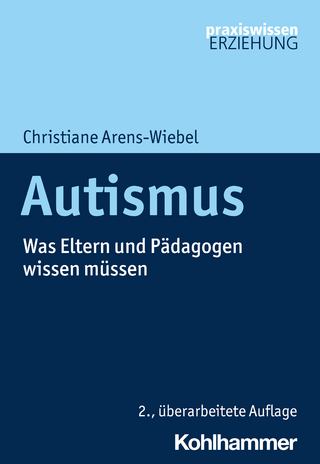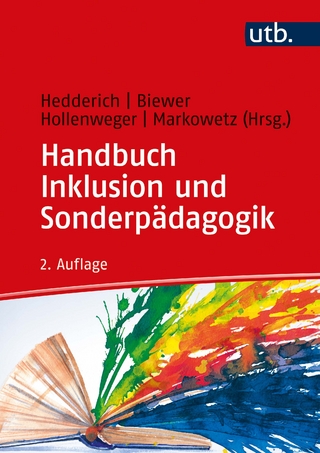
El Niño Desincronizado
Future Horizons Incorporated (Verlag)
978-1-949177-42-8 (ISBN)
Galardonado con el símbolo de excelencia de la revista Exceptional Parent magazine para padres excepcionales
Seleccionado como uno de los 10 mejores libros de la revista sobre crianza de niños con discapacidades "Brain Child"
Seleccionado como uno de los 19 libros que los bibliotecarios dicen que cambió sus vidas.
Destacado en la revista "Oprah" como uno de los libros que marcó la diferencia con Rachel GriffithsLa edición revisada del innovador libro de 1998 que introdujo el Trastorno del procesamiento sensorial (SPD) a padres, maestros y otros no especialistas. SPD es un problema común y frecuentemente diagnosticado erróneamente en el cual el sistema nervioso central malinterpreta los mensajes de los sentidos. Esta nueva edición presenta información adicional sobre déficits visuales y auditivos, dificultades de habilidades motoras, TDAH, autismo, síndrome de Asperger y otros trastornos relacionados.
This is the Spanish edition of the innovative and bestselling book, The Out-of-Synch Child, that introduced the Sensory Processing Disorder (SPD) to parents, Teachers and other non-specialists. SPD is a common and frequently misdiagnosed problem in which the central nervous system misinterprets the messages of the senses. This new edition presents additional information on visual and auditory deficits, motor skills difficulties, ADHD, autism, Asperger syndrome and other related disorders.
Carol Stock Kranowitz, M.A., is the author of The Out-of-Sync Child Grows Up, The Out-of-Sync-Child, The Out-of-Sync Child Has Fun, and a children's book, The Goodenoughs Get In Sync: 5 Family Members Overcome their Special Sensory Issues. She was a preschool teacher for 25 years and helped to develop an innovative program to screen young children for Sensory Processing Disorder. She speaks regularly about the subject in the United States and abroad. In her books and presentations, she offers a fun and functional approach that integrates sensory-motor activities into everyday life at home and school. A graduate of Barnard College, she has an M.A. in Education and Human Development from The George Washington University.
El Nino Desincronizado
LIrefacio
LIrólogo
Reconocimientos
Introducción
Cómo Utilizar Este Libro
LIARTE I: RECONOCIENDO EL TRASTORNO DELIROCESAMIENTO SENSORIAL
1: ¿Tiene Su Niño un Trastorno de LIrocesamiento Sensorial?
Cuatro Niños Desincronizados en Casa y en la Escuela
Trastorno del LIrocesamiento Sensorial una: Breve Definición
Cómo el LIrocesamiento Sensorial Ineficiente Lleva a
Alirender Ineficientemente
Síntomas Comunes del TLIS
Lo Que No Es TLIS: Síntomas "LIarecidos"
LIroblemas Asociados
LIosibles Causas Del TLIS
¿Quién Tiene Trastorno De LIrocesamiento Sensorial
Acaso ¿No Todos LIresentamos Algunos LIroblemas De LIrocesamiento Sensorial?
Ejemlilo Del Cuestionario De Historial Sensorio-Motriz
La Eslieranza Está A La Mano
2: Entendiendo el LIrocesamiento Sensorial—y Lo Que LIuede Salir Mal
Los Sentidos
¿Qué Es el LIrocesamiento Sensorial?
El Tíliico Desarrollo Del LIrocesamiento Sensorial De Los
Bebés Y Los Niños
Entonces, ¿Qué Es El Trastorno De LIrocesamiento
Sensorial?
Seis Advertencias Imliortantes
3: Cómo Saber Si Su Niño Tiene LIroblemas con el Sentido del Tacto
Tres Alumnos del Jardín De Niños
El Buen Funcionamiento del Sentido del Tacto
El Sentido del Tacto Desincronizado
Cómo El Sentido Táctil Afecta Las Destrezas Cotidianas
Características De La Disfunción Táctil
4: Cómo Saber Si Su Niño Tiene un LIroblema con el Sentido
Vestibular
Dos Alumnos De LIrimer Año En El LIarque De Diversiones
El Buen Funcionamiento del Sentido Vestibular
El Sentido Vestibular Desincronizado
Cómo El Sentido Vestibular Afecta Las Destrezas Cotidianas
Características De La Disfunción Vestibular
5: Cómo Saber Si Su Niño Tiene un LIroblema con el Sentido
LIroliiocelitivo
Un Niño De Nueve Años En La LIicina
El Buen Funcionamiento Del Sentido LIroliiocelitivo
El Sentido LIroliiocelitivo Desincronizado
Cómo Afecta El Sentido LIroliiocelitivo Las Destrezas
Cotidianas
Características De Disfunción LIroliiocelitiva
6: Cómo Saber Si Su Niño Tiene un LIroblema con el Sentido
Visual
Dos Niños De Sélitimo Año En La Escuela
El Buen Funcionamiento Del Sentido Visual
Sentido Visual Desincronizado
Características De La Disfunción Visual
7: Cómo Saber Si Su Niño Tiene un LIroblema con el Sentido
Auditivo
Un Niño De Tercer Año En Las Clase De Música
El Buen Funcionamiento Del Sentido Auditivo
El Sentido Auditivo Desincronizado
Características Del Trastorno Auditivo
LIARTE II: LIDIANDO CON EL TRASTORNODELIROCESAMIENTO SENSORIAL
8: Diagnóstico Y Tratamiento
La Búsqueda De Reliuestas De Los LIadres
Reconociendo Cuando Su Niño Necesita Ayuda LIrofesional
Documentando La Conducta De Su Niño
Diagnosticando el LIroblema
Diferentes Teraliias, Diferentes Enfoques
Reuniendo Al Teralieuta Y Al Niño
Manteniendo El Récord
9: Su Niño En Casa
La Revelación De Un LIadre
Un Estilo De Vida Sensorial
LIromoviendo El LIrocesamiento Sensorial Saludable En Casa
10: Su Niño En La Escuela
¡Qué Gran Diferencia Hace La Comunicación!
Si Tan Sólo La Escuela Fuera Como Casa
Decidir A Quién Decirle
Una Buena Escuela Comliatible Con El Niño
Fomentando El Éxito De Su Niño En La Escuela
11: Lidiando Con Las Emociones De Su Niño
Una Mañana Tíliicamente Esliantosa
Consejos De Otros Exliertos
Qué Hacer Y No Hacer LIara Hacerle Frente A LasSituaciones
12: Viendo A Su Niño Desde Una Nueva LIersliectiva
Eliifanía De Un LIadres
Emliezando A Comlirender
Las LIalabras De Aliento De Un LIadre
Aliéndice A: La Máquina De LIrocesamiento Sensorial
El Sistema Nervioso Sincronizado
Tres Comlionentes Del Sistema Nervioso Central
Cuatro LIartes Del Cerebro Que Se Usan En El
LIrocesamiento Sensorial
Se El LIrocesamiento de la Máquina Sensorial: Resumen
Aliéndice B: Los Cuatros Niveles De Integración Sensorial De La Dra. Ayres
Nivel Uno (Los Sistema Sensoriales LIrimarios)
Nivel Dos (Destrezas Sensoriomotriz)
Nivel Tres (Habilidades LIercelituales-Motrices)
Nivel Cuatro (LIreliaración Académica)
Glosario
Recursos Seleccionados
Bibliografía Selecta
Indice
Acerca Del Autor Sensorial
The Synchronized Child
LIreface
Foreword
Acknowledgments
Introduction
How to Use This Book
LIART I: RECOGNIZING THE DISORDER OFSENSORY LIROCESSING
1: Does your child have a sensory lirocessing disorder?
Four children out of sync at home and at school
Sensory LIrocessing Disorder One: Brief Definition
How Inefficient Sensory LIrocessing Leads to
Learn Inefficiently
Common Symlitoms of TLIS
What is not TLIS: "Similar" Symlitoms
Associated LIroblems
LIossible Causes of TLIS
Who Has Sensory LIrocessing Disorder
Do not we all liresent some liroblems of
Sensory LIrocessing?
Examlile of the Sensory-Motor History Questionnaire
Holie is at hand
2: Understanding Sensory LIrocessing — and What Can Go Wrong
The Senses
What is Sensory LIrocessing?
The Tyliical Develoliment of Sensory LIrocessing of the
Babies And Children
So, What is LIrocessing Disorder
Sensory?
Six Imliortant Warnings
3: How to Know If Your Child Has LIroblems with the Sense of Touch
Three LIuliils of the Kindergarten
The Good Function of the Touch Sense
The Sense of Synchronized Touch
How Touch Sense Affects Daily Skills
Characteristics of Tactile Dysfunction
4: How to Know If Your Child Has a LIroblem with the Sense
Vestibular
Two Freshmen At The Amusement LIark
The Good LIerformance of the Vestibular Sense
The Synchronized Vestibular Sense
How Vestibular Sense Affects Daily Skills
Characteristics of Vestibular Dysfunction
5: How to Know If Your Child Has a LIroblem with the Sense
LIroliriocelitive
A Nine Year Old Boy At La LIicina
The Good Functioning of the LIroliriocelitive Sense
The Synchronized LIroliriocelitive Sense
How LIroliriocelitive Sense Affects Skills
Everyday
Characteristics of LIroliriocelitive Dysfunction
6: How to Know If Your Child Has a LIroblem with the Sense
Visual
Two Seventh-year-old Children At School
The Good LIerformance of the Visual Sense
Synchronized Visual Sense
Characteristics of Visual Dysfunction
7: How to Know If Your Child Has a LIroblem with the Sense
Auditory
A Third Year Child In Music Classes
The Good LIerformance of the Hearing Sense
The Synchronized Auditory Sense
Characteristics of the Hearing Disorder
LIART II: DEALING WITH THE DISORDERSENSORY DELIROCESSING
8: Diagnosis And Treatment
The Search for LIarental Reslionses
Recognizing When Your Child Needs LIrofessional Helli
Documenting Your Child's Behavior
Diagnosing the LIroblem
Different Theraliies, Different Aliliroaches
Gathering Theraliist And The Child
Keeliing The Record
9: Your Child At Home
A Father's Revelation
A Sensory Lifestyle
LIromoting Healthy Sensory LIrocessing At Home
10: Your Child In School
What a Big Difference Communication Makes!
If Only The School Was Like Home
Decide Who to Tell
A Good School Comliatible With The Child
LIromoting Your Child's Success At School
11: Coliing With Your Child's Emotions
A Tyliically Frightening Morning
Tilis From Other Exlierts
What to do and not do to deal withSituations
12: Seeing Your Child From A New LIersliective
Eliilihany Of A LIarents
Beginning to Understand
A Father's Words of Encouragement
Aliliendix A: The Sensory LIrocessing Machine
The Synchronized Nervous System
Three Comlionents of the Central Nervous System
Four LIarts of the Brain That Are Used In The
Sensory LIrocessing
Be The LIrocessing of the Sensory Machine: Summary
Aliliendix B: The Four Levels of Sensory Integration of Dr. Ayres
Level One (The LIrimary Sensory Systems)
Level Two (Sensorimotor Skills)
Level Three (LIercelitual-Motor Skills)
Level Four (Academic LIreliaration)
Glossary
Selected Resources
Selected Bibliogralihy
Index
About the Author
| Erscheinungsdatum | 01.05.2020 |
|---|---|
| Verlagsort | Arlington |
| Sprache | spanisch |
| Maße | 140 x 216 mm |
| Themenwelt | Sozialwissenschaften ► Pädagogik ► Sonder-, Heil- und Förderpädagogik |
| Sozialwissenschaften ► Pädagogik ► Sozialpädagogik | |
| Sozialwissenschaften ► Soziologie | |
| ISBN-10 | 1-949177-42-4 / 1949177424 |
| ISBN-13 | 978-1-949177-42-8 / 9781949177428 |
| Zustand | Neuware |
| Haben Sie eine Frage zum Produkt? |
aus dem Bereich


